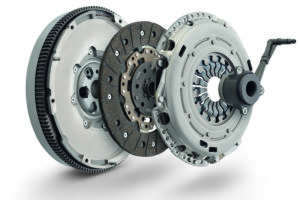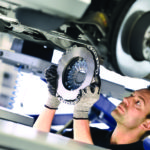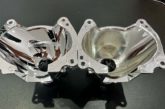Wayne McClusky, Technical Training manager, ZF Services UK, outlines the common causes and issues associated with clutch or DMF failure.
It’s well acknowledged that a newly- replaced component (compared to a worn one) can be considerably different in terms of performance, so replacing parts in pairs is a practice recommended and undertaken by many workshops to maintain vehicle characteristics.
The same principle can also apply to the components within a clutch kit or ZMS module – these kits typically comprising a clutch disc, clutch pressure plate, clutch release bearing and dual mass flywheel (DMF) – as in an integrated system, all parts depend on each other to function correctly.
In this article we’ll be outlining the common causes and issues associated with clutch or DMF failure, and highlighting why complete clutch kit replacement is one of the most practical and cost-effective solutions for independent workshops.
Typical causes of clutch failure
Today the service life of individual clutch components is almost identical, although this can depend on applied stress and driving style, both of which can speed up failure.
There are a number of key wear problems which may cause a clutch to malfunction or fail. For example, clutch slip can arise through issues such as: an incorrectly installed cover assembly; a lubricant contaminated clutch disc; incorrectly re- machined flywheels; or installation of the wrong clutch for the application. This can result in the clutch cover overheating, causing accelerated rates of clutch friction lining wear.
Diagnosing DMF faults
Clutch issues can also lead to DMF damage. For example, if the clutch’s friction lining wears out completely through excessive clutch slip, the plate’s metal backing will grind into the DMF’s surface. This can be identified through a visual inspection; damage will show a discoloured friction surface on the secondary flywheel. Similarly, excessive overheating will harden the special lubricant in the DMF, which frequently leads to component failure. In addition, if there are visible fissures in the friction surface, the DMF has to be replaced – otherwise it may crack.
What’s more, excessive DMF oscillation may cause premature wear to the arc springs within, which can typically be as a result of slow starting speeds. Other causes of DMF failure can be as a result of driving in too high a gear, allowing the engine to be idle for long periods or frequent engine stalling. Educating the customer about the possible causes may help extend the life of a DMF.
In some cases the DMF may be identified as the issue because of excessive noise and vibration, when in fact it is other components within a vehicle which are at fault. These other faults can also accelerate damage to the DMF, if not resolved promptly.
Clutch kit diagnosis
When diagnosing a fault in the clutch, a systematic approach should be taken to guarantee the correct causes are identified and the appropriate steps taken to repair the system. The majority of clutch wear and damage can be identified through visual inspection and the source of damage traced back to issues such as excessive heat or vehicle overload. However, faults that may be considered to be associated with the DMF may actually be within the vehicle’s mechanical or electronic systems. As clutch and DMF replacement is often considered a time consuming and laborious task, it’s best to identify the issue in the first instance to avoid unnecessary labour time and costs.
Nevertheless, whether the damage is within the clutch itself or the DMF, it’s recommended that the entire clutch kit is changed. Replacing the vehicle clutch and DMF during the same repair operation not only improves workshop throughput, but delivers savings for the customer in terms of labour costs and future vehicle downtime. For workshops, the task of dismantling and replacing the clutch kit exceeds the cost of the replacement part so, by fitting the parts together, you’ll be saving time in the future.
“ZF Services UK runs regular technical training sessions, which can help workshops to better diagnose and resolve common clutch and DMF issues. Visit: www.zf.com/uk/technical-training to find out more.”
Replacing the clutch kit
It’s clear that replacing a vehicle’s clutch and DMF during the same repair operation is extremely practical for both the workshop and the customer. However, when comparing price and availability of parts for the job, the workshop may end up buying a clutch from one brand and a DMF from another brand, with both parts possibly purchased from different motor factors. In addition to being a time consuming way of sourcing components, any brand mismatch introduces the potential for incompatibility in the clutch and DMF system.
Furthermore, a workshop purchasing a clutch kit rather than sourcing parts individually saves time and costs, with the accompanying potential for additional profit margin. As a result, the need for product returns is reduced to virtually zero, as long as the parts aren’t damaged in transit, mistakes made in vehicle variant identification or incorrect fitting techniques applied.
ZF clutch kits
To help simplify decision making for customers, ZF Services UK has applied its experience of supplying the aftermarket with clutches and DMFs, and developed a complete kit for renewing the components on a range of vehicles. The SACHS clutch kit range contains the clutch cover, clutch drive plate and DMF, together with new fixing screws and assembly grease.
Depending on the application, some kits also include the clutch release bearing or concentric slave cylinder. All of the major components in each kit are original equipment (OE) SACHS branded parts,
manufactured by ZF, certified by major VMs for use in their vehicles and meet their exacting specifications for fit and performance. The use of OE parts is advisable not only for long-term reliability and maximum component life, but also to ensure that product quality is never in question when dealing with vehicles still covered by the manufacturer’s warranty.
For the workshop, purchasing a clutch kit that comprises OE branded components such as SACHS parts, rather than sourcing parts individually, provides peace of mind in terms of reliability and there’s also the added bonus of gaining a complete sale rather than competing with other workshops. For customers, replacing the components in one session will ultimately save cost in terms of workshop labour and reduced vehicle downtime.










